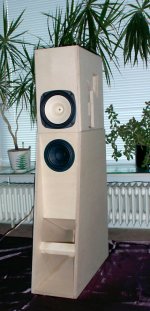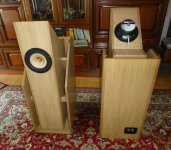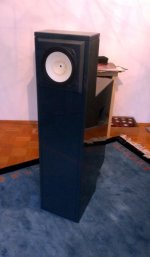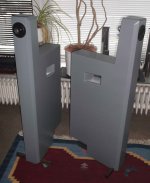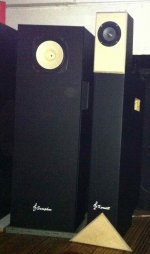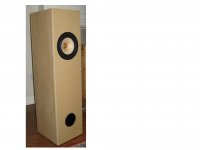for tubes ?
Hello,
look a few of my double horns,
best Impedanz , NO bass resonanz.
for classic i would prefer the B200 Visaton.
Hello,
look a few of my double horns,
best Impedanz , NO bass resonanz.
for classic i would prefer the B200 Visaton.
Attachments
Last edited:
Poor Joca, rather than reducing his options he's presented with more. All of them will work. If you are in a small room even the low efficiency drivers will work.
Here's another design using a similar driver to the Fostex you already own. Simply seal it up and place on top of a powered subwoofer.
S.E.Xy Speakers | Bottlehead
The driver you own really deserves a proper back horn to perform its best. That's what it has been designed for. But you can do other things while getting very good results like OB or Sealed - both with bass support - and get an idea if you like the Fostex sound signature. Additionally, you can see if it plays loud enough with your amp. Then you can determine if you want to try drivers that have lower efficiency.
Every speaker is a compromise. It's a matter of minimizing what you don't like in order to increase your musical enjoyment.
Here's another design using a similar driver to the Fostex you already own. Simply seal it up and place on top of a powered subwoofer.
S.E.Xy Speakers | Bottlehead
The driver you own really deserves a proper back horn to perform its best. That's what it has been designed for. But you can do other things while getting very good results like OB or Sealed - both with bass support - and get an idea if you like the Fostex sound signature. Additionally, you can see if it plays loud enough with your amp. Then you can determine if you want to try drivers that have lower efficiency.
Every speaker is a compromise. It's a matter of minimizing what you don't like in order to increase your musical enjoyment.
Joca expressed his preference for classical music.
Then I'd advice him to stay away from socalled full range speakers, especially the wizzer cone variety.
These are simply too colored and uneven in frequency response to do justice to classical music reproduction.
Better to choose a slightly less efficient speaker with neutral balance like one of TG's classical 3-way options.
Then I'd advice him to stay away from socalled full range speakers, especially the wizzer cone variety.
These are simply too colored and uneven in frequency response to do justice to classical music reproduction.
Better to choose a slightly less efficient speaker with neutral balance like one of TG's classical 3-way options.
I am not a believer in full range, especially when it comes to complex music material.
I however second what Horst told you above: Visaton B200 has something special going on when playing out classical instruments. this driver is atypical and begs for a horn application, so I would definitely recommend you too check out his horns at Hornlautsprecher . some commercial (pi?) speakers were also made around that driver.
i currently have it on an OB but I always remember when I was breaking those in playing them through some cardboard boxes how striking the classical music sounded.
I however second what Horst told you above: Visaton B200 has something special going on when playing out classical instruments. this driver is atypical and begs for a horn application, so I would definitely recommend you too check out his horns at Hornlautsprecher . some commercial (pi?) speakers were also made around that driver.
i currently have it on an OB but I always remember when I was breaking those in playing them through some cardboard boxes how striking the classical music sounded.
Well, i think i have found what i was looking for. The problem is the € involved. I guess i will have to leave with the fact that only later this year i'll have the project finished. The DTQWT-mkIII - DTQWT-mkIII
Can't resist to do it. Really impressed by the design.
Can't resist to do it. Really impressed by the design.
I am a classical musician who dabbles in loudspeaker building. That makes my views a bit atypical. Building speakers is all about compromise, and you have to pick your own.
For me the most important aspect of a classical music speaker is the leading note transients. A piano or a violin reproduction for example is dulled without really crisp transients, and loses all magic, and becomes just ordinary. But lack of colouration I feel is far less important. I have found colouration not that noticeable on classical music. This is the opposite of what I expected to find. And a less than flat frequency response bothers me less on classical music. It might be to do with the lack of repetition compared to pop music.
I listen at lower levels than many on this site. If you listen at high levels, my opinions might not be applicable.
For me the most important aspect of a classical music speaker is the leading note transients. A piano or a violin reproduction for example is dulled without really crisp transients, and loses all magic, and becomes just ordinary. But lack of colouration I feel is far less important. I have found colouration not that noticeable on classical music. This is the opposite of what I expected to find. And a less than flat frequency response bothers me less on classical music. It might be to do with the lack of repetition compared to pop music.
I listen at lower levels than many on this site. If you listen at high levels, my opinions might not be applicable.
Hi,
I'm a noob in this field, but in short words, what i am trying to do, is a speaker for my usual listening music. Classical and rock/pop music. It will be mainly for classical. I am in the process of making the tubelab SSE and the firstwatt F5. They will be the amps for the new speakers. I'm reading a lot in the foruns , but can't decide the way to go. I've read about fullrange speakers, FAST systems, open baffle,and others. So, i'm pretty overwhelmed by the possibilities. i can't spend more than 300€ in speakers for one channel. they need to be high sensitivity speakers, i think. because of the amps i'm building. ~
thank you
Just to present even more options, I would suggest coax...something like 12" or better yet 15". Tannoy, B&C, Radian...in appropriate box to suit the driver.
A few drivers to consider would be from Fostex (165, 206 or 207), Tangband (1808), Wild Burro Betsy
Measured sensitivities of 92, 95/96, 93 (207 is discontinued), 89/90 (ie the TB is not nearly as efficient as its specs), i haven't had a recent Betsy to measure.
FAST is where i'd go as well. Our successes have used A7x, FF85k, FF85wk with woofers from Mark Audio (EL166, A12pw), Peerless (830870), and Silver Flute (W14). And we keep working on more. For an efficient system i would use Alpair 10p on top (we have initial drawings for an OB A10p mated with at least 2 OB 10s).
There are a huge number of possibilities for doing FASTs, Lots of decent FRs to use on the top, and a myriad of midBasses made for typical cone + dome boxes. Having 2 amps to bi-amp with dramatically opens up the possibilities.
dave
Question for midrange
As someone who listens to almost exclusively classical I find this very interesting - what loudspeakers are you using at the moment?
I am a classical musician who dabbles in loudspeaker building. That makes my views a bit atypical. Building speakers is all about compromise, and you have to pick your own.
For me the most important aspect of a classical music speaker is the leading note transients. A piano or a violin reproduction for example is dulled without really crisp transients, and loses all magic, and becomes just ordinary. But lack of colouration I feel is far less important. I have found colouration not that noticeable on classical music. This is the opposite of what I expected to find. And a less than flat frequency response bothers me less on classical music. It might be to do with the lack of repetition compared to pop music.
I listen at lower levels than many on this site. If you listen at high levels, my opinions might not be applicable.
As someone who listens to almost exclusively classical I find this very interesting - what loudspeakers are you using at the moment?
Joca, you selected a very interesting and unique speaker to build. Enjoy the process and enjoy the music for many years to come.
Midrange, I agree with your classical music comments. Fast and dynamic drivers really help portray the life and brilliance of classical that gets lost with less capable speakers. I also find a big woofer helps portray the huge swells in volume swings that give goosebumps. Open baffle (and back horns) throw a wider image (less pin-point) that I believe enhances enjoyment.
What's interesting about Joca's selection is not just the unique main drive unit, but the way the large rear firing woofer shares the cabinet with the main driver. Very cool but will probably require room placement experimentation. Never heard the JA unit but I believe I read long ago it's similar to a highly regarded Seas (that Audio Note used?)... If anyone knows the history please share.
Dave, I agree, none of the TB drivers live up to their elevated efficiency ratings. Neither do they live up to their published frequency chart. Despite that, I still enjoy building designs and listening to them. They always sound pretty good to me.
Midrange, I agree with your classical music comments. Fast and dynamic drivers really help portray the life and brilliance of classical that gets lost with less capable speakers. I also find a big woofer helps portray the huge swells in volume swings that give goosebumps. Open baffle (and back horns) throw a wider image (less pin-point) that I believe enhances enjoyment.
What's interesting about Joca's selection is not just the unique main drive unit, but the way the large rear firing woofer shares the cabinet with the main driver. Very cool but will probably require room placement experimentation. Never heard the JA unit but I believe I read long ago it's similar to a highly regarded Seas (that Audio Note used?)... If anyone knows the history please share.
Dave, I agree, none of the TB drivers live up to their elevated efficiency ratings. Neither do they live up to their published frequency chart. Despite that, I still enjoy building designs and listening to them. They always sound pretty good to me.
I am a classical musician who dabbles in loudspeaker building. That makes my views a bit atypical. Building speakers is all about compromise, and you have to pick your own.
For me the most important aspect of a classical music speaker is the leading note transients. A piano or a violin reproduction for example is dulled without really crisp transients, and loses all magic, and becomes just ordinary. But lack of colouration I feel is far less important. I have found colouration not that noticeable on classical music. This is the opposite of what I expected to find. And a less than flat frequency response bothers me less on classical music. It might be to do with the lack of repetition compared to pop music.
I listen at lower levels than many on this site. If you listen at high levels, my opinions might not be applicable.
Hi. You made me stop for a while. I am also a classical musician. Can you explain better what you mean by transient sound. I'm portuguese and my english vocabulary is limited. You can explain in classical terms maybe. My audiophile vocabulary is poor.
Relatively to the coaxial drivers like tannoy, b&c and radian, is that they are more expensive and defenitly out of my price range.
The Fast system mentioned by dave looks good. It was one of my first choices before my initial post. Doubt only remains if i will hear Mahler, Sibelius (organ) and stravinsky with nice results because of the lower frequencies.
Sorry for my possible dumb questions.
Hope to read more from you all. I paused my decision in building the TG DTQWL-mkIII because of the comments of a classical musician. Hope you understand why. I will continue to read and search more. Thank you for your wisdom and knowledge.
Joca
I find interesting you are placing your bets (and the forum members) on impressive main range drivers. Adason post is in the same line as my first opinion if I remember. Difficult choice but really a good ride home with such good projects/drivers. A recent project from another member involved a 15" coax for a professional testing set-up. A "small" paper cone mid or wide-range like the JA8008 or the Visaton with fast transients might not be worse. Have fun.Well, i think i have found what i was looking for. The problem is the € involved. I guess i will have to leave with the fact that only later this year i'll have the project finished. The DTQWT-mkIII - DTQWT-mkIII
Can't resist to do it. Really impressed by the design.
I'd be nervous that the dtqwt-mkIII would overwhelm your room. I'd hate to see you spend all that money and time only to find they don't work for you. Getting good organ performance will be a challenge that could involve some experimentation so I'd leave some room in my budget. The room size has to be considered. How loud will you listen?
I am also a classical musician. Can you explain better what you mean by transient sound.
Many newbie builders become extremely impressed after building a new speaker that is far more expensive than what they currently have or have heard... Don't be fooled by this 😉 But the good news is, it would apply to you too if you decide to throw big $$$ (as long as you don't try to design the speaker yourself)...
Many successes in DIY speaker designs are driven by "luck" not by design prowess. So, be careful also to the claim that certain driver or design is good, because most of the time it works because it is easy to do so or have the tendency to work in a typical application...
As a musician, I believe you have developed a sensitive feeling towards certain quality of sound reproduction. When you play your music, you focus on things like "pitch", "cadence", "leading note", etc... What this has to do with DIY audio is that you will be very sensitive to TIMING of the instruments. IME, this has to do with PHASE behavior. This is considered INAUDIBLE by people, but I suspect that musician ears can "feel" it.
So, related to the phase, be careful with designs that have huge group delay or irregular phase response. Any efforts to lower bass response will be problematic, such as a transmission line enclosure or even the linkwitz's transform circuit...
Also be careful with the DTQWT where the midbass is "loaded" with different subwoofer in the same enclosure. Most people will be very impressed by the effect, but be very careful if you have discriminating ears, especially towards phase anomalies... (I'm not saying it is wrong because I have never heard it, but be careful. And the low impedance might not suit your SE amp).
As a musician, you may find "transient" as very important. This may lead you to designs such as FR, TL, OB and the like. Most of these designs have compromise that some people wont take, especially if they know how (which is difficult) to get "transient" from normal multi-way speakers.
With your Fostex experience it is obvious that you are okay with the peaks and frequency response irregularities. Instrumental music like classic may not heavily need accurate reproduction. But what if you also listen to pop/rock/vocal? But relax, it will be just fine if you don't know what you are missing...
In line with FR/TL/OB designs, have you looked at and studied the Stradivary concept? The short depth of the enclosure may give you the sound you seek. It is unnatural of course, and microscopically brings fatigue, but most probably is irrelevant to you.
Classic music has "rich" complex musical passages. FR in general will not be optimum for this. You want a speaker that can display the sound of each instrument detached from each other. This is the reason why I prefer stiff cone material, despite high difficulty in achieving natural sound. Multi-way (three) is another way to achieve this, and this is also in line with your absolute need of low bass (double bass, organ, piano).
Regarding amplifier, its very unfortunate that you prefer low wattage low damping amps. This makes speaker choice more difficult/limited... If you decide to go with multi-way, may be simple crossover (such as LR2) is a better option.
Tang Band W8-1772 full range ~$200 in USA. Very good reviews around the world.
There are a few MLTL cabinet designs for the W8-1772, including Bob Brines thead and website. RL-Circuits for near-wall vs. in-room baffle step adjustment are available.
------
Every cabinet shape has resonances. To control these resonances, a well designed ported bass reflex box will use a combination of: prime ratios for W*D*H; bracing materials; and stuffing.
MLTL = Mass Loaded Transmission Line = build a pipe with one main bass resonant frequency and tune a bottom port to that resonant frequency. A MLTL cabinet alignment is tall and narrow in order to extend the bass with the energy from a quarter-wave resonant tuned transmission line that exits into a bottom port. Read up at: Quarter Wavelength Loudspeaker Design
There are a few MLTL cabinet designs for the W8-1772, including Bob Brines thead and website. RL-Circuits for near-wall vs. in-room baffle step adjustment are available.
------
Every cabinet shape has resonances. To control these resonances, a well designed ported bass reflex box will use a combination of: prime ratios for W*D*H; bracing materials; and stuffing.
MLTL = Mass Loaded Transmission Line = build a pipe with one main bass resonant frequency and tune a bottom port to that resonant frequency. A MLTL cabinet alignment is tall and narrow in order to extend the bass with the energy from a quarter-wave resonant tuned transmission line that exits into a bottom port. Read up at: Quarter Wavelength Loudspeaker Design
Attachments
Joca, If you decide to spend ~$400 - $500 on multi-way speakers per channel.
For a modest size listening room of 4.65meters width * 6.80 meters Length* 2.35 height, I would study controlled directivity speakers which use a horn/waveguide to keep the higher frequencies from short delay(<5ms) reflections which destroy the true sound stage.
Geddes controlled directivity white paper:
http://www.gedlee.com/downloads/directivity.pdf
----------
Good 95db/watt designs:
1) Econowave with 12" midbass + SEOS12 waveguide. Low cost + simple construction + proven
Fusion-12 DIY Sound Group
2) Spain's Beyma 12" woofer plus horn+CD
http://www.beyma.com/uploads/descargas/1383756426.pdf
3) If you are a talented builder: 3-way Synergy horn
http://www.diyaudio.com/forums/multi-way/241976-synergy-horns-no-drawbacks-no-issues.html
For a modest size listening room of 4.65meters width * 6.80 meters Length* 2.35 height, I would study controlled directivity speakers which use a horn/waveguide to keep the higher frequencies from short delay(<5ms) reflections which destroy the true sound stage.
Geddes controlled directivity white paper:
http://www.gedlee.com/downloads/directivity.pdf
----------
Good 95db/watt designs:
1) Econowave with 12" midbass + SEOS12 waveguide. Low cost + simple construction + proven
Fusion-12 DIY Sound Group
2) Spain's Beyma 12" woofer plus horn+CD
http://www.beyma.com/uploads/descargas/1383756426.pdf
3) If you are a talented builder: 3-way Synergy horn
http://www.diyaudio.com/forums/multi-way/241976-synergy-horns-no-drawbacks-no-issues.html
Jay makes good points about the transient accuracy of speakers. For this you should look into transient perfect designs with 1st order crossover and time aligned drivers. Also look for low group delay designs and this can be achieved with damped TL's. If you are willing to go bi-amped active xo then a miniDSP can allow you to select the optimal xo for transient perfect behavior which requires special EQ applied with a xo filter and time delay.
With your Fostex experience it is obvious that you are okay with the peaks and frequency response irregularities. Instrumental music like classic may not heavily need accurate reproduction. But what if you also listen to pop/rock/vocal? But relax, it will be just fine if you don't know what you are missing...
Utterly nonsense...
Acoustical instruments and the most precious of them, the voice, ask for the best possible accurate reproduction.
With pop/rock we have no clue of how this should sound as a lot of electronics is involved, not just in the music but also in the recording/mastering process.
Jay makes good points about the transient accuracy of speakers. For this you should look into transient perfect designs with 1st order crossover and time aligned drivers. Also look for low group delay designs and this can be achieved with damped TL's. If you are willing to go bi-amped active xo then a miniDSP can allow you to select the optimal xo for transient perfect behavior which requires special EQ applied with a xo filter and time delay.
Agreed. Transient and phase/time accuracy had been overlooked by many consumer speaker products, albeit those parameters are always considered to be very important in professional field. A few audiophiles who realized this importance have moved to full-range or dsp + multi-amp, but many still don't care this. I still think frequency response flatness does matter, so I chose latter, DSP + multiple lows watt class A amps.
Some commercial speakers with passive crossover such as Dunlavy shows excellent spec in both transient and frequency response, but they are usually not efficient at all.
Utterly nonsense...
Acoustical instruments and the most precious of them, the voice, ask for the best possible accurate reproduction.
With pop/rock we have no clue of how this should sound as a lot of electronics is involved, not just in the music but also in the recording/mastering process.
Acoustic recording is also not only processed by a lot of electronics, but also the choice of the mic is the most deciding factor of the sound in any kind of music except pure electronic music, so we can only "guess" how acoustic instrument actually sounded in the recording room or hall.
Also, vocal mic is considered to be more like an electro acoustic effect equipment in professional field. M49, U47, etc. all sound extremely different each other. And almost all of the recorded vocal has been processed heavily with multiple comps and EQs, such as Plulec and LA2A, hopefully not autotune. 😛
Last edited:
- Status
- Not open for further replies.
- Home
- Loudspeakers
- Full Range
- Speakers for Classical music - tubelab SSE; firstwatt F5
